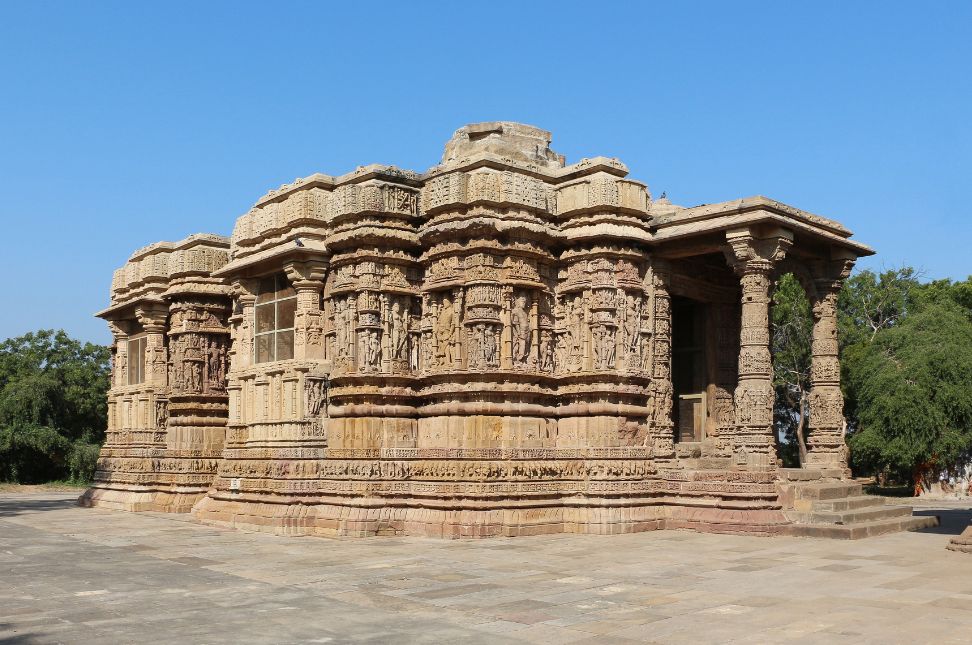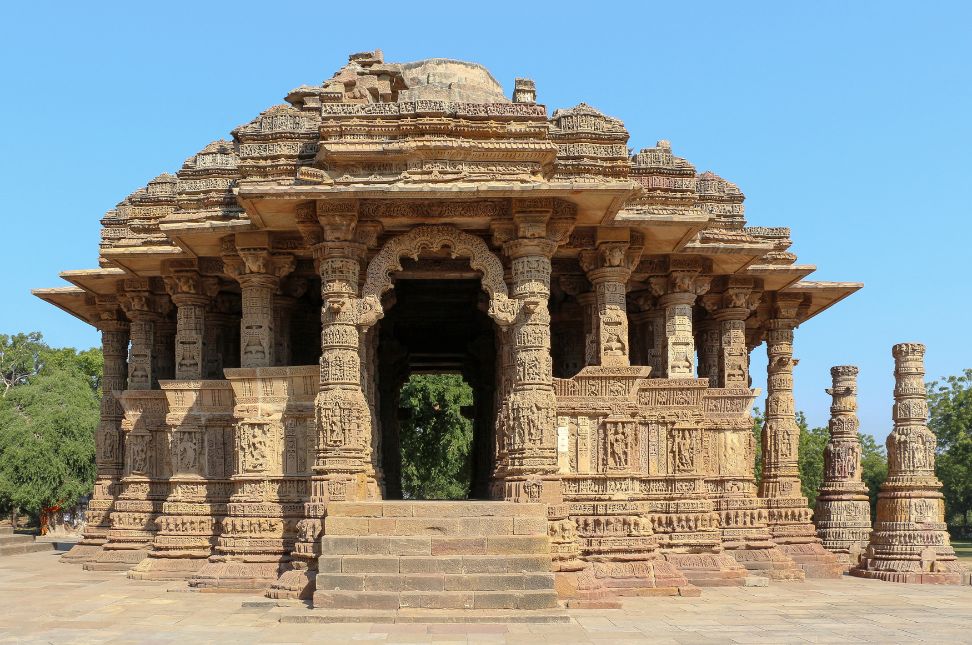India’s rich cultural heritage is often showcased through its magnificent temples, and one of the most breathtaking examples is the Modhera Sun Temple. Located in Gujarat, this temple is dedicated to the Hindu Sun God, Surya, and is an architectural marvel. For travelers from Tier 1 countries like the US, UK, Canada, and Australia, visiting the Modhera Sun Temple offers a chance to witness centuries-old craftsmanship, stunning symmetry, and unparalleled beauty. The temple stands as a testament to India’s architectural brilliance and its deep spiritual roots.
History of Modhera Sun Temple
The Modhera Sun Temple was built in 1026 CE by King Bhima I of the Solanki dynasty, a period known for artistic and architectural advancement. The temple was constructed at a time when the Solankis worshipped the Sun God as a symbol of divinity, power, and prosperity. The temple complex is designed to capture the sun’s rays, aligning perfectly with astronomical events like the equinoxes and solstices, emphasizing the deep connection between nature, architecture, and religion.
Though the temple was partially damaged by invaders, its grandeur remains intact. Today, the Modhera Sun Temple is a protected monument under the Archaeological Survey of India, attracting visitors from around the globe who are keen to explore this architectural wonder.
Architectural Brilliance of Modhera Sun Temple
The Modhera Sun Temple is renowned for its exquisite architecture and intricate carvings. The temple is divided into three main sections: the Surya Kund, the Sabha Mandap, and the Guda Mandap. Each section represents different aspects of devotion, spirituality, and architectural genius.
- Surya Kund (Stepwell):
As you enter the temple complex, the first thing you’ll encounter is the Surya Kund, a large rectangular stepwell designed to store water for ritualistic purposes. The stepwell is adorned with over 100 small shrines, each dedicated to different deities, making it not only functional but also an artistic masterpiece. The symmetrical design of the steps leading down to the water is a stunning visual treat, showcasing the perfect blend of utility and beauty. - Sabha Mandap (Assembly Hall):
The Sabha Mandap is an open hall used for gatherings and religious ceremonies. The hall is supported by intricately carved pillars, each telling a story through their detailed sculptures. The carvings depict scenes from Hindu epics such as the Ramayana and Mahabharata, as well as various forms of dance and music, symbolizing the cultural richness of the time. The symmetrical design and precision of these carvings reflect the advanced architectural knowledge of the craftsmen who built the temple. - Guda Mandap (Main Shrine):
The heart of the Modhera Sun Temple is the Guda Mandap, where the idol of the Sun God once resided. While the idol no longer remains, the sanctum still showcases breathtaking architecture. The main shrine is built in a way that allows sunlight to fall directly on the idol during the equinoxes, illuminating the temple’s interiors in a divine glow. The Guda Mandap’s carvings are some of the finest examples of stone artistry, with figures of celestial beings, gods, and symbolic motifs all meticulously crafted.
The Sun’s Influence on the Temple Design
The Modhera Sun Temple was constructed to align with the movements of the sun, making it one of the most advanced examples of solar architecture in India. The temple is positioned in such a way that during the equinoxes, the first rays of the sun hit the main sanctum, symbolizing the Sun God’s blessings. This celestial connection not only enhances the temple’s religious significance but also highlights the advanced understanding of astronomy and architecture that existed over a thousand years ago.
The Solanki dynasty, which built the temple, was often referred to as the descendants of the Sun God, and the temple reflects this deep spiritual connection. This unique architectural feature sets the Modhera Sun Temple apart from other historical structures in India.
Cultural Significance of the Modhera Sun Temple
The Modhera Sun Temple is not just a marvel of architecture; it holds immense cultural and spiritual importance. In ancient times, the temple was a prominent pilgrimage site where devotees would offer prayers to the Sun God, seeking his blessings for health, prosperity, and success. The rituals conducted at the temple were closely linked to the movements of the sun, emphasizing the role of natural elements in religious practices.
Though the temple no longer functions as a place of active worship, it continues to inspire awe and reverence. The temple’s association with Surya, the Sun God, highlights the significance of solar worship in ancient Indian culture. Visiting the Modhera Sun Temple offers travelers a deeper understanding of India’s spiritual heritage and the importance of natural elements in its religious practices.
Modhera Dance Festival: A Cultural Celebration
One of the most vibrant aspects of Modhera Sun Temple is the annual Modhera Dance Festival, held every January. Organized by the Gujarat Tourism Department, this festival celebrates the traditional classical dance forms of India. The festival is set against the backdrop of the temple, adding to its grandeur and creating an ethereal atmosphere for visitors.
For tourists from Tier 1 countries, the Modhera Dance Festival provides a unique opportunity to witness Indian culture through dance and music. The combination of ancient architecture and contemporary performances creates a perfect blend of history and modernity. It’s a celebration of India’s artistic heritage that should not be missed.
How to Reach Modhera Sun Temple
Modhera Sun Temple is located about 100 kilometers from Ahmedabad, Gujarat’s largest city, making it easily accessible for both domestic and international travelers. For those arriving from abroad, Ahmedabad’s Sardar Vallabhbhai Patel International Airport offers connections to major cities in the US, UK, Canada, and Australia.
From Ahmedabad, travelers can take a bus, hire a taxi, or drive to Modhera. The road journey takes around two hours and offers scenic views of Gujarat’s countryside. The temple is also well-connected by rail, with regular train services to nearby towns and cities. For visitors looking to explore more of Gujarat’s architectural and cultural heritage, the Modhera Sun Temple is conveniently located near other famous landmarks such as the Rani ki Vav stepwell and Patan.
Best Time to Visit Modhera Sun Temple
The best time to explore Modhera Sun Temple is during the winter months, from October to March. The weather during this period is pleasant, making it ideal for outdoor exploration. Visitors who want to experience the Modhera Dance Festival should plan their trip in January, when the temple comes alive with music, dance, and cultural performances.

In the summer months, the heat can be intense, making it less comfortable to explore the temple grounds. However, early morning visits during this time can still offer a peaceful experience, with fewer crowds and the chance to witness the temple in solitude.
Architectural Influence on Modern Design
The architectural style of the Modhera Sun Temple has influenced many modern structures, both in India and abroad. Architects and designers continue to draw inspiration from the temple’s precise geometry, intricate carvings, and integration of natural elements like sunlight. The stepwell design of the Surya Kund, for example, has been replicated in various modern buildings, showcasing the timeless appeal of ancient Indian architecture.
For international travelers and design enthusiasts, the Modhera Sun Temple offers insights into how ancient architectural techniques can still inspire contemporary design. Its emphasis on symmetry, functionality, and aesthetic beauty make it a valuable study for anyone interested in architecture.
Conclusion: A Must-Visit Destination
In conclusion, the Modhera Sun Temple is not just a place of religious significance but a symbol of India’s architectural brilliance. With its stunning design, intricate carvings, and celestial alignment, the temple offers a unique experience for travelers from Tier 1 countries. Whether you are interested in history, architecture, or spirituality, the Sun Temple provides a deep connection to India’s ancient past.
For those visiting Gujarat, a trip to the Modhera Sun Temple is a must. The temple’s cultural significance, combined with its architectural genius, makes it one of India’s most iconic landmarks. By visiting this site, you’ll not only witness an ancient wonder but also gain a greater appreciation for India’s artistic and spiritual heritage.




